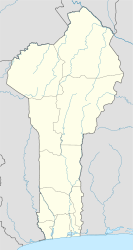Ouidah
| Ouidah | ||
|---|---|---|
|
|
||
| Coordinates | 6 ° 22 ′ N , 2 ° 5 ′ E | |
| Basic data | ||
| Country | Benin | |
| Atlantique | ||
| ISO 3166-2 | BJ-AQ | |
| height | 16 m | |
| Residents | 32,474 (1992) | |
Ouidah (pronunciation: wē'dä; alternative name Hweda and especially in the English-speaking area Whydah (hwī'də)) is a city in the Republic of Benin . As the only port in Benin, Ouidah was the center of the slave trade in the region and an active trading city. The city has been the de facto capital of the Atlantique department since 1999, but has not yet been officially appointed.
The area of the municipality is 364 km² and includes ten districts (arrondissements), four of them urban (Ouidah I, II, II and IV) and six rural (Djègbadji, Avlékété, Savi, Pahou, Gakpé and Houakpé). Ouidah has around 80,000 inhabitants. The main livelihood of the population is agriculture and handicrafts, there are a few small entrepreneurs and the only industrial company is the “ British American Tobacco ” factory on the main road between Cotonou and Grand-Popo . Pierre C. Badet has been mayor since 2003. The city council has 17 members.
The actual city was already around 3.5 kilometers from the sea at the time of the Dahomey Kingdom , so slaves had to cover this distance on foot before embarking.
history
Ouidah was originally called Ajudá and was the capital of the heavily populated, prosperous kingdom of Sahé (Savi).
In 1680 the Portuguese built a fortress in Ouidah on behalf of the governor of São Tomé , but it was abandoned after a few decades. In 1721 it was rebuilt under the name São João Baptista d'Ajudá . In 1727 the city was conquered by King Dossou Agadja von Dahomey. The name Ajudá was no longer used; the kingdom of Sahé fell in 1728.
In 1858 the Portuguese abandoned the São João Baptista de Ajudá fortress again. In 1861 the King of Dahomey gave the fortress to missionaries from France . On February 23, 1865, the Portuguese demanded the building back, so that it was again subordinate to the governor of São Tomé until 1869. In 1913 the authorities moved a Decauville railway from the beach to the city to stimulate trade.
On August 1, 1961, the fortress of Dahomey, which was held by a few Portuguese, was forcibly occupied and annexed. In 1975 the takeover of Portugal was officially recognized.
In 1992, 32,474 people lived in Ouidah.
Attractions
Ouidah offers many sights, especially in terms of cultural history. Among the main attractions include the historic museum in the reconstructed Portuguese fort of São João Baptista d'Ajuda, the Holy Forest, the so-called slave route by former slave market (Place Cha Cha) to the beach up to the gate of no return (fr. Du Non Retour Porte ) leads. There are numerous statues and memorials related to the slave trade along the route. This and the gate were restored in 1992 with financial support from UNESCO , the Place Cha Cha in 1999 with financial support from the Reconstruction Loan Corporation . The focus is on the Catholic Basilique de l'Immaculée Conception . Every year on January 10th, a large voodoo festival takes place on Ouidahs beach , during which the voodoo king performs various ceremonies; The city also attracts voodoo pilgrims as a place of pilgrimage . The Quintessence film festival , which also takes place annually in January and is one of the most important in West Africa along with the film festival in Ouagadougou (Burkina Faso) , is also of interest to cineastes .
Others
The book The Viceroy of Ouidah by the British writer Bruce Chatwin is largely set in Ouidah at the time of the slave trade.
People from Ouidah
- Émile Derlin Henri Zinsou (1918–2016), from 1968 to 1969 President of Dahomey, today's Benin
- Édouard Joshua Adjanohoun (1928–2016), botanist
- Isidore de Souza (1934–1999), Archbishop of Cotonou
- Angélique Kidjo (* 1960), Benin-French musician, choreographer, singer and composer
Web links
Individual evidence
- ↑ Dahomey. London, HM Stationery Office, 1920. p. 19.
- ↑ allevents.in: Vodou / Voodoo festival in Benin (Ouidah voodoo pilgrimage 2012)


